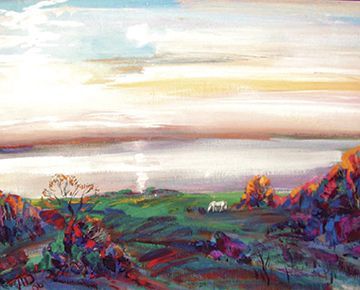Artist Leonid Danelia discovered his creativity during his student years, learning drawing from his father, famous Belarusian artist Piotr Danelia, who headed the fine arts studio in Brest for more than 20 years.

‘August Evening’
In 1963, Leonid entered Minsk’s Art College, during the time of ‘the thaw’. Young artist-teachers Leonid Shchemelev and Algerd Malishevsky showed students works by foreign and Russian avant-garde artists, despite some viewing such innovations with hostility. Youthful rebelliousness promised Leonid Danelia expulsion from college but, within two years, he gained a place at the Theatre-art Institute, where teachers were more tolerant of ‘experimental’ attitudes. It was a time of optimism and the spirit of creativity reigned in the student environment. “Three important components — Poetry, Music and Painting — claimed our souls,” Leonid Danelia recollects.

‘Flowers of April’
After graduating from the Institute, Leonid gained experience in decorative and applied arts in Minsk, working under masters of architecture. This helped him later, in his independent work. Design experts were in demand, which led to Leonid gaining employment for several years at ‘Beltorgreklama’. Then he worked at a Minsk industrial art enterprise, helping create various socially significant sites.

‘At the Beginning of Spring’
However, Leonid never forgot his love of painting and his design job freed him to devote his leisure time to this pursuit. In 1976, Leonid presented at his first show: a canvas entitled ‘Morning in the Old City’. The landscape differed in having an original composition, created in decorative manner. He aimed to move audiences by creating a certain mood, via composition and use of colour. Soon, his ‘Ruins at Pointblank’, devoted to poet Maxim Bogdanovich, attracted the attention of critics, alongside others works by Leonid.

Leonid Danelia is a versatile artist, brought up in the traditions of realistic art, yet finding his own path. He understood that, through the academic, he could find philosophical self-expression. His outlook in the field of graphics, architecture and painting was revealed gradually. Knowing the language of these arts helps him still, to combine love, kindness and responsiveness in his art.
Maxim Bogdanovich’s poetry had a strong influence on Leonid, who sought to convey this love. In 1993, his ‘Veronica’ clearly featured a withered tree in the foreground, symbolising the poet’s unfulfilled dreams. On the thorny path of the artist, Leonid notes, “Painting displays the soul in an emotional splash. Behind each experiment is your intelligence, your professional experience and your store of knowledge. Fellini, the well-known Italian director, became saddened by his ‘store of knowledge’, wishing to experience the world anew, with children’s eyes. Sometimes, in order to express our state of mind, we must seek out original, graphic language, changing our manner of presentation.”

In class
For some time, Leonid has been working in an abstract-impressionist style, although it truly defies categorisation. He uses strong colours and returns repeatedly to the theme of women’s beauty, accented with romanticism and a clear note of experimentation. Having mastered formal methods, he is keen to discover something new.

‘Recollections of Childhood’
Leonid takes part in various foreign exhibitions, and his works can be found in private collections worldwide: in France, Germany, the USA, Russia, Poland, Holland and the UK. Austrian ‘Arviviente’ publishing house has included his works in its album ‘Belarusian Visual Artists’ and helped Leonid, alongside other Belarusian artists participate at Christie’s auction, in London.

‘Naroch Landscapes’
Today, Leonid teaches at the Belarusian State Pedagogical University Named after Maxim Tank, sharing his knowledge of design, painting and drawing with his students. His interests are wide and versatile. Raised with the traditions of national realistic art, he sought an alternative, through graphics, applied and decorative art, architecture and painting, combining expressive colour and lines to decorative effect.
Romantic artist Leonid Danelia has always embraced diversity. In his recent works, he has aspired to abstract impressionism, despite depicting concrete images. Abstraction, grounded in feasibility, allows him to express emotions through paint; music and poetry are evident within his canvases

Museum of Olympic Glory. Design by L. Danelia
“Creative people have a certain philosophy and outlook,” notes Leonid. He stresses an endless search, which won’t allow the soul to rest, despite its knowledge of the world’s incomparable beauty and internal harmony.

Leonid Danelia with the students of the Belarusian State Pedagogical University Named after Maxim Tank
Does the process of creativity ever end?
Creativity is a continuous process. Very often, dreams provide ideas, for me at least. They often prompt colour and composition.
Recently, you became interested in the eternal artistic theme of womanhood
Life is many-sided, but eternal truths are always with us. The muse in the life of the artist is an angel of balance and an inspiration.
Your last pictures, ‘Full Moon’, ‘Flowers of Autumn’, ‘Wind of Freedom’, ‘Time to Fulfil Desires’, ‘Dreams and Loneliness’, and ‘Well into the Night’ are painted in an original manner and filled with vital energy. They are festive, and seductive in their beauty and simultaneously powerful with an internal female force …
We can never generalise about individual perceptions, since we each have our own. It’s wonderful. A creator only gives us their individual vision and sensations.

‘Birds Come Back’
* * *
The artist responds with his heart and his artistry to Belarus’ pain. Leonid Daneliya’s previous personal exhibition in Germany ended with an auction, selling twenty of his pictures, to raise funds for Belarusian children who have suffered as a result of the Chernobyl disaster.
He continues working, revealing his personality through art, and passing his rich experience to his students: his great mission.
By Veniamin Mikheev


































